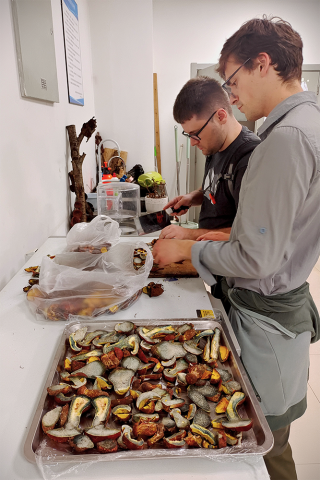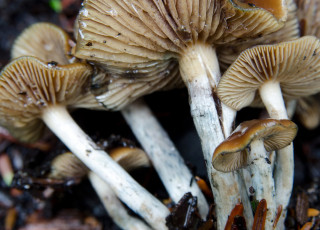Experts Explore New Mushroom Which Causes Fairytale-Like Hallucinations
By Colin Domnauer
Picture this: You're enjoying a delicious bowl of mushroom soup, when suddenly you notice hundreds of tiny people dressed in cartoonish clothing marching across your tablecloth, jumping into your bowl, swimming around, and clinging to your spoon as you lift it for another taste. You're not dreaming — you've just experienced the effects of a mushroom known scientifically as Lanmaoa asiatica. It belongs to an entirely different class of Fungi than the more commonly known “magic mushrooms” and remains far more mysterious.
When outsiders first embarked into the Western Highlands of Papua New Guinea in 1934, they encountered a perplexing sight: after consuming a type of wild mushroom which they called “nonda,” the local people would appear to go temporarily insane, exhibiting a sudden and striking change in mood and behavior. Subsequent accounts of the “mushroom madness” phenomenon, as it was termed, provided more details into the mushroom's strange psychological effects.

Conversing with sellers to find and purchase samples for scientific study of the psychoactive mushroom known as Jian shou qing. There are many potentially confusing look-alikes, but after asking the seller if this is the one that will make us see little people, their amused response, often accompanied with a personal anecdote, served as our confirmation of its identity. Colin Domnauer
Specifically, it was reported that those affected would experience lilliputian hallucinations — a rare, clinically defined psychiatric syndrome (named after the tiny people in Gulliver's Travels) characterized by the perception of numerous little people autonomously moving about and interacting in the real-world environment. One elder tribesman in Papua New Guinea describes this effect, explaining how “he saw tiny people with mushrooms around their faces. They were teasing him, and he was trying to chase them away.”
By the 1960s, scientists were working to identify the species of mushrooms involved and what chemicals within them might be responsible for such bizarre effects. However, both questions have remained unanswered to this day. As a Ph.D. student at the Natural History Museum of Utah, I've been working to solve this puzzle: What exactly is the identity of this mushroom, how widespread is the cultural knowledge of its effects, and why does it produce such fantastical visions?
Investigating Lilliputian Mushrooms in China
Home to 40 percent of the world's wild edible fungi, Yunnan, China has always been remarkable for mushroom lovers. But in the last decade or so, the summer rains have brought more than just mushrooms; they’ve been accompanied by an explosion of news articles that read like something out of children's fairy tales: after consuming a popular wild mushroom known locally as “Jian shou qing,” locals frequently report having unbelievably bizarre experiences, most notable characterized by seeing “xiao ren ren,” or little people.

Mushroom markets are scattered throughout the capital city of Kunming, ranging in size from a few street blocks to no less than the largest wild mushroom market in the world, where upwards of 200 species of edible fungi are sold. Colin Domnauer
A professor in Yunnan recounted how one evening during dinner (Jian shou qing is openly sold in markets and restaurants), he began seeing swirling shapes and colors after eating stir-fried mushrooms. Since the psychoactive effects are familiar to most locals, he began looking for xiao ren ren but was disappointed to find none — until he lifted the tablecloth and peeked underneath, seeing “hundreds of xiao ren ren, marching like soldiers.”
Even more curious, he said, “when I lifted the tablecloth higher, the heads came off and stuck to the bottom of the cloth and the bodies kept marching in place… I did this many times, at two-minute intervals, and each time they were there, marching and grinning… I measured them, too… they were 2 cm high.” According to records at Yunnan Hospital, 96 percent of patients affected by this mushroom report seeing an abundance of "little people" or "elves," often dancing, jumping, or marching around their real-world environment.

Evidence of China being the largest global exporter of wild mushrooms can clearly be seen through the abundance of dried mushrooms distributed here at Mushuihua Market. Within this immensity, however, lies potential oversight, and danger. For wild harvested species such as Jian shou qing that are unable to be cultivated under controlled conditions, commercial packages may mistakenly contain a mixture of similar looking, though certainly different, species of mushrooms. Indeed, after DNA sequencing the contents of online packages labelled as dried Jian shou qing mushroom, we found multiple poisonous species to be present, with no trace of the psychoactive species it was purported to contain. Colin Domnauer
As recently as 2014, the taxonomic identity of the psychoactive Jian shou qing mushroom remained unknown. It wasn’t until mycologists in Yunnan purchased and sequenced the mushrooms being sold in an open-air street market (where it had been sold for decades) that the species was officially described and recognized as being new to science. Its formal Latin name is Lanmaoa asiatica, and, interestingly, it’s more closely related to the common porcini (Utah’s official state mushroom) than to any other currently known hallucinogenic mushroom species.
Although Lanmaoa asiatica is a recent scientific discovery, the knowledge and use of this psychoactive mushroom may have much deeper ancient roots in Chinese culture. A prominent Daoist text from the 3rd century CE refers to a “flesh spirit mushroom,” which, according to the text, if consumed raw, allows one to “see a little person” and “attain transcendence immediately.”
A Global Experience
Surprisingly, I became aware of yet another independent report of the exact same phenomenon — a mushroom that caused lilliputian hallucinations, but this time from an entirely different region of the world. Indigenous communities in the Philippines' remote Northern Cordillera were collecting and consuming a wild mushroom which, according to local knowledge, occasionally evokes visions of little people, which they call the “ansisit.” The mushroom is known locally as "Sedesdem." Just as the “Nonda” in Papua New Guinea and “Jian shou qing” in Yunnan, it is a culturally esteemed wild edible mushroom that, if undercooked, produces bizarre yet remarkably consistent psychoactive effect.

One of the most frequently encountered and popular edible species sold in Yunnan is Lanmaoa asiatica. Locals call it Jian shou qing, which roughly translates to “turns blue in the hand,” a reference to its rapidly changing colors when touched. Highly valued for its unique and rich flavor, it is equally notorious for its powerful hallucinogenic effects when undercooked: many recount stories of having fantastical perceptions of hundreds of colorful little people interacting with them and their environment — a syndrome known clinically as Lilliputian Hallucinations. The chemicals responsible for the strange effect remain unknown. Colin Domnauer
As no scientific surveys of the mushrooms in the Northern Philippines had been conducted, Sedesdem’s taxonomic identity remained unknown, leaving me with the obvious task. I travelled to this community in 2024 to explore the mushrooms and experience the culture surrounding this phenomenon. By working with local guides and foraging through the forest, we collected samples that are now preserved for scientific study at the Natural History Museum of Utah — allowing us to perform the first DNA sequencing of this region's fungi.
What surprised me most was the unexpected discovery of the Sedesdem mushroom’s identity: it was none other than Lanmaoa asiatica, the exact same species as in Yunnan. The puzzle was coming together.
More Than Folklore or Tall Tales
That the same peculiar hallucinations are independently reported across such distant cultures indicates that these bizarre psychological effects are not cultural fabrications or coincidences, but manifestations of a shared underlying chemical and neurological basis.
Chemical and genomic analyses performed on Lanmaoa asiatica at the Natural History Museum of Utah have revealed no traces of any known psychoactive compounds, suggesting that something entirely new is waiting to be discovered. In other words, Lanmaoa asiatica appears to harbor a chemical compound capable of reliably evoking this unusual experience of lilliputian hallucinations. The discovery of that chemical may, in fact, hold the key to understanding one of the most mysterious dimensions of the human psyche.
Ongoing Research Into the Fairytale Mushroom

After several pounds of fresh mushrooms are purchased from the market, they must be prepared for chemical preservation to avoid genetic and chemical degradation. This process required slicing each mushroom into thin sections, before freezing and dehydrating. The iconic feature (and namesake) of Jian shou qing — that it turns blue within seconds after cutting — can clearly be seen here. Colin Domnauer
Our efforts to identify this compound are ongoing, and the progress so far has been exciting! When mice are given chemical extracts of Lanmaoa asiatica, their behavior shifts noticeably compared to controls. By continuing to fractionate these extracts and testing each in turn, we’ve been steadily narrowing in on isolating the specific bioactive molecules involved.
But the chemistry is only part of the mystery. In parallel, I’m building a global database of all Lanmaoa species. In doing so, I’ve discovered four new species previously unknown to science. Through full-genome sequencing, I’ve been able to clearly map the evolutionary relationships and history of Lanmaoa for the first time, allowing us to search for patterns that might reveal where and why psychoactivity evolved in this group. For example, genomic analysis reveals that the closest relative of L. asiatica is a species commonly found (though rarely eaten) here in North America. While there are no reports of it being psychoactive in the US, it’s entirely plausible its effects have simply gone unnoticed.
Exciting Discoveries Are Waiting for Us
I’m fascinated by how far the knowledge of these mushrooms extends, across both space and time. Are there additional cultural traditions and groups surrounding this psychoactive species that have yet to be documented? Does humanity’s knowledge of this mushroom and its most bizarre effects stretch further into history, and deeper into folkloric beliefs, that we currently appreciate? Given the remarkable findings we’ve made in just the past few years, I believe the answer to both these questions is yes.
While many questions remain, one thing is for certain: Lanmaoa asiatica reminds us that the world of mushrooms, even those found in markets and on dinner plates, conceals mysteries and wonders we’ve yet to imagine. Somewhere between traditional folklore and modern biology, between the wild forest floor and the sterile scientific laboratory, lies a story still unfolding, a story that may begin with something as seemingly innocuous as a bowl of mushroom soup.
1 of 8











